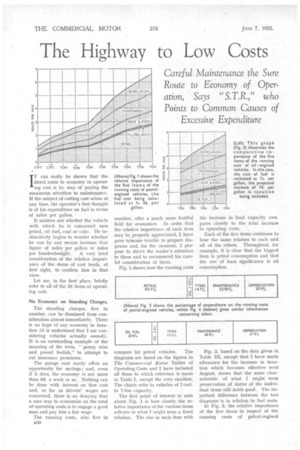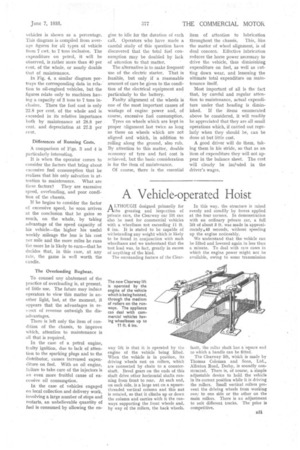The Highway to Low Costs
Page 44

Page 45

If you've noticed an error in this article please click here to report it so we can fix it.
Careful Maintenance the Sure
Route to Ee onomy of Oper ation, Says " S.T.R.," who Points to Common Causes of
Excessive Expenditure
/T can easily be shown that the direct route to economy in operating cost is by way of paying the maximum attention to maintenance. If the subject of cutting cost arises at any time, the operator's first thought is of his expenditure on fuel in terms of miles per gallon.
It matters not whether the vehicle with which he is concerned uses petrol, oil fuel, coal or coke. He instinctively begins to wonder whether he can by any means increase that figure of miles per gallon or miles per hundredweight. A very brief consideration of the relative importance of the .items of cost tends, at first sight, to confirm him in that view.
Let me, in the first place, briefly refer to all of the 10 items of operating cost.
No Economy on Standing Charges.
The standing charges, five in number, can be dismissed from consideration almost immediately. There is no hope of any economy in taxation (it is understood that I am considering vehicles actually owned). It is an outstanding example of the meaning of the term, "penny wise and pound foolish," to attempt to cut insurance premiums.
The garage rent rarely offers an opportunity for savings ; and, even if it does, the economy is not more than 6d. a week or so. Nothing can be done with interest on first cost and, so far as drivers' wages are concerned, there is no denying that a sure way to economize on the total. of operating costs is to engage a good man and pay him a fair war.
The running costs, also five in number, offer a much more fruitful field for economies. In order that the relative importance of each item may be properly appreciated, I have gone to'o;ome trouble to prepare diagrams and, for the moment, I propose to direct the reader's attention to these and to recommend his careful consideration of them.
Fig. 1 shows how the running costs compare for petrol vehicles. The diagrams are based on the figures in The Commercial Motor Tables of Operating Costs and I have included all those to which reference is made in Table I, except the very smallest. The charts refer to vehicles of 7-cwt. to 7-ton capacity.
The first point of interest to note about Fig. 1 is how closely the relative importance of the various items adheres to what I might term a fixed relation. The rise in each item with the increase in load capacity corn pares closely to the total increase in operating costs.
Each of the five items continues to bear the same relation to each and all of the others. Throughout, for example, it is clear that the biggest item is petrol consumption and that the one of least significance is oil consumption.
Fig. 2, based on the data given in Table III, except that I have made allowance for the increase in taxation which becomes effective next August, shows that the same characteristic of what I might term preservation of status of the individual items still holds good. The important difference between the two diagrams is in relation to fuel costs.
In Fig_ 3, the relative importance of the five items in respect of the running costs of petrol-engiried vehicles is shown as a percentage. This diagram is compiled from average figures for all types of vehicle from 7 cwt. to 7 tons inclusive. The expenditure on petrol, it will be observed, is rather more than 40 per cent, of the whole, or nearly double that of maintenance.
In Fig. 4, a similar diagram portrays the corresponding data in relation to oil-engined vehicles, but the figures relate only to machines having a capacity of 3 tons to 7 tons inclusive. There the fuel cost is only 22.8 per cent, of the whole and is exceeded in its relative importance both by maintenance at 28.8 per cent, and depreciation at 27.3 per cent.
Differences of Running Costs.
A comparison of Figs. 3 and 4 is particularly interesting.
It is when the operator comes to consider the factors that bring about excessive fuel consumption that he realizes that his only salvation is attention to maintenance. What are these factors? They are excessive speed, overloading, and poor condition of the chassis.
If he begins to consider the factor of excessive speed, he soon arrives at the conclusion that he gains so much, on the whole, by taking advantage of the speed capacity of his vehicle—the higher his useful weekly mileage the less is his cost per mile and the more miles he runs the more he is likely to earn—that he decides that, in this case, at any rate, the game is well worth the candle.
The Overloading Bugbear.
To counsel any abatement of the practice of overloading is, at present, of little use. The future may induce operators to view this matter in another light, but, at the moment, it appears that the advantages in resoect of revenue outweigh the disadvantages.
There is left only the item of condition of the chassis, to improve which, attention to maintenance is all that is required.
In the case of a petrol engine, faulty ignition, due to lack of attention to the sparking plugs and to the distributor, causes increased expenditure on fuel. With an oil engine, failure to take care of the injectors is an even more fruitful cause of excessive oil consumption,
In the case of vehicles engaged on local collection and delivery work, involving a large number of stops and restarts, an unbelievable quantity of fuel is consumed by allowing the en gine to idle for the duration of each call. Operators who have made a careful study of this question have discovered that the total fuel consumption may be doubled by lack of attention to that matter.
The alternative is to make frequent use of the electric starter. That is feasible, but only if a reasonable amount of care be given to the condition of the electrical equipment and particularly to the battery.
Faulty alignment of the wheels is one of the most important causes of wastage of engine power and, of course, excessive fuel consumption.
Tyres on wheels which are kept in proper alignment last twice as long as those on wheels which are not aligned and which, in addition to rolling along the ground, also rub. By attention to this matter, double economy of tyre and fuel cost is achieved, but the basic consideration is for the item of maintenance.
Of course, there is the essential item of attention to lubrication throughout the chassis. This, like the matter of wheel alignment, is of dual concern. Effective lubrication reduces the horse power necessary to drive the vehicle, thus diminishing expenditure on fuel, as well as cutting down wear, and lessening the ultimate total expenditure on maintenance itself.
Most important of all is the fact that, by careful and regular attention to maintenance, actual expenditure under that heading is diminished. If the items enumerated above be considered, it will readily be appreciated that they are all small operations which, if carried out regularly when they should be, can be done at but little cost.
A good driver will do them, taking them in his stride, so that as art item of expenditure they will not appear in the balance sheet. The cost will clearly be included in the driver's wages.




























































































